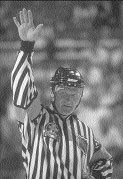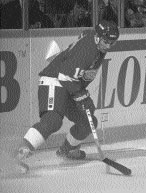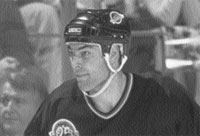Respect Your Officials
Respect your officials
By Fred Pletsch
Nov 6, 2001, 20:37
 This first appeared in the 12/1995 issue of Hockey Player Magazine® |
| Terry Gregson. ©BBS |
The perfect hockey referee should have the speed of a sprinter, the endurance of a marathon runner, the mind of a professor, and the tact of a diplomat. And it helps if they’re stone deaf and have 20/20 vision, too.
Terry Gregson always gets a laugh from the last part of that description. But the one-time president of the NHL Officials Association is striped-shirt serious when he says he has some real concerns about the state of officiating today at the youth hockey level.
Gregson, 1994’s Number One ranked official according to the NHL rating system, and the man chosen to work Game Seven of the Stanley Cup Finals that year, watched a lot of youth-level games during last season’s NHL lockout.
“The USA Hockey referee development program and the Canadian Level Six program are producing qualified officials for elite levels, but you’ve got to see people through the formative years to get them to that point,” says Gregson. And I’m not sure that’s being done.”
Five years is the average amount of time a person serves as a hockey official and, according to Gregson, shattered confidence is the main reason they give it up.
No slack for the ref
“If a 14-year-old defenseman makes a bad pass or a bad play in a game, everybody says, ‘That’s okay, he’s just learning.’ But if a 16-year-old referee, who’s basing everything he’s doing on personal judgment, makes a slight error in judgment, everybody is all over him.”
People will always have an emotional interest in the outcome of a game, but Gregson does encourage youth hockey organizations to hold open meetings for parents, coaches and team personnel—mandatory attendance once a season would be his ideal—to give them some insight into what officiating is all about.
Officials are on the ice to keep the playing field level, and apply the rule book in the interests of fairness and justice. Coaches, players and fans, on the other hand, judge the outcome in terms of a win or a loss—and it is the vested interest in victory that colors their emotions toward officials. Gregson says it’s amazing how perspective changes when the “win/lose” factor is removed from the equation.
“I’ve been involved in heated Stanley Cup games and been visited between periods by personnel already eliminated from the playoffs. They’ll say things like, ‘There have been some tough calls to make out there, but you guys are doing a great job.’” Meanwhile, two weeks earlier in a series involving their team, those same people were prepared to nominate Gregson for the title of worst referee in the history of hockey!
Gregson strongly believes that all coaches should be made to work a few games as a referee or linesman.
“It’s easy to criticize when you haven’t walked in their shoes, but maybe (they) should try it and see what it’s like, because I don’t think for a minute we are going to get people to watch hockey from a neutral standpoint. But I think they should watch it from a more respectful position.”
The 42-year-old Gregson feels that young players can be encouraged to serve as officials because it’s going to get them more of that precious ice time. “When you serve as an official,” Gregson notes, “the hockey-playing skill that’s bound to improve is your skating, because you do so much of it.”
Do the hustle
And if youngsters are going to try the zebra’s life, they should remember that effort is critical. “First impressions are important, and I think it’s important for young referees and linesmen to show lots of hustle—because if you look the part, and are a good skater, people will probably accept your judgment and point of view a little better.”
Visual awareness is an acquired talent that Gregson believes can help be developed through officiating, thereby enhancing a player’s skill level. “You can’t have tunnel vision and be a good official. You have to learn to see the whole ice,” says Gregson. “You’re able to watch breakouts develop and forechecking systems. It’s going to give you a better understanding of the game if you pay attention. An experienced official knows how the game is going to develop, and the ‘hot spots’ on the ice to watch for. Officiating can help improve a youngster’s field of vision on the ice.”
It’s imperative that youth hockey organizations start treating their officials as they would another member team. “There should be ice time available for clinics for officials to get out there with their head official and do some practicing,” stresses Gregson. “Teams get time to practice and coaches get time to get together and discuss drills and techniques. But how often do officials get together during the season—in a non-threatening environment—to work on positioning, maybe get a refresher course on new rules, and be critiques by an experienced peer?”
Officials, likewise, should consider themselves another “team” in the community. A sense of teamwork can be instilled through pizza party video analysis or hot-stove nights, hockey social outings, and charity fund-raising projects.
“You might think I’m talking from an idealistic perspective,” says Gregson, “but I strongly feel (officials) should form (their) little association and make it feel like another team in the community.”
The person in charge of assignments in a hockey association must realize the enormous power they wield in shaping the development of impressionable young linespeople and refs. Gregson advises that assignments be done in a very thoughtful manner, and recommends that a young official be teamed with an experienced one at all times.
On an individual basis, Gregson tells officials to just be themselves: quietly confident but never cocky, arrogant or stand-offish.
He says the difference between the best officials and the rest is how one handles confrontations. You’ll get a lot further by communicating, Gregson points out, than by coming on in an aggressive manner.
Fred Pletsch is a veteran OHL and AHL broadcaster who currently covers the Cornwall Aces for CJFS radio.
This first appeared in the 12/1995 issue of Hockey Player Magazine®
© Copyright 1991-2001 Hockey Player® and Hockey Player Magazine®






